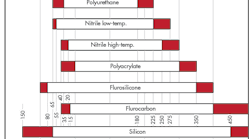Low temperatures can be very unkind to hydraulic seals. They reduce their resiliency, shrink them, and make them stiff and hard. These outcomes can be avoided if engineers and designers balance four critical factors before choosing the seal material: low-temperature resilience, hardness, thermal contraction, and seal shape.
Resiliency is probably best measured by using the TR-10 temperature retraction test or the material’s TR-10 rating. The test determines the temperature at which a material exhibits memory or resilience. However, the hydraulic fluid which will be used with the seal also plays a role in resiliency.
If the seal absorbs the fluid, for example, it will swell; the fluid ends up acting like a plasticizer to keep the seal flexible at low temperatures. If the seal shrinks, however, it’s a sure sign plasticizer is leaching out of the seal. This means the seal will become stiff at 5° to 10°F higher than its rated TR-10 temperature.
Experience indicates that most thermoset elastomers seal statically at 15° to 20°F below the TR-10 temperature. For continuous dynamic operations, however, specified temperatures should be equal to or slightly above the TR-10 temperature.
Hardness in a seal material increases as temperature drops. For example, a nitrile compound with a hardness of 70 Shore A at room temperature may harden to 85 Shore A at -30°F. At that level, it may not seal at low pressures, although it could work properly at moderate and high pressures. Although softer seals may work better at low temperatures, they usually have shorter lives—particularly at higher temperatures.
Thermal contraction can be critical for low-temperature seals, especially for dynamic pistons where squeeze or the compressive force on the seal is minimal. A rough rule of thumb says that elastomers have coefficients of expansion 10 times greater than those of steels.
Thermal contraction is worse on toroidal seals that try to stops leaks with their outer circumferences than those that rely on their inner circumference to stop leaks. For example, on a piston seal, the seal shrinks away from the sealing surface, whereas on a rod seal, it shrinks toward the sealing surface.
Seal shape and the shape of the seal contact area affects wear and hydroplaning characteristics. Seals hydroplane, riding up on a film of fluid and making all or most of their stroke without breaking the film. This action provides excellent lubrication for the seal and may work well for piston seals, but hydroplaning is the main source of leaks with rod seals.
Seal hydroplaning increases as temperatures decrease because fluid viscosity increases with decreasing temperatures.
Beveled lips on seals can prevent hydroplaning because high unit loading forces exerted on them breaks the film and wipes the rod dry. Unfortunately, these higher forces also increase wear on the seal.
If engineers properly balance all these factors with their application’s needs, they can balance a seal’s physical and material properties. This will result in seals with fewer leaks and longer lives.

